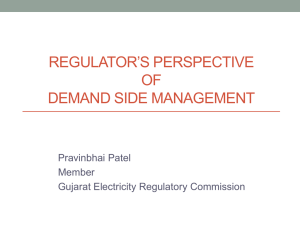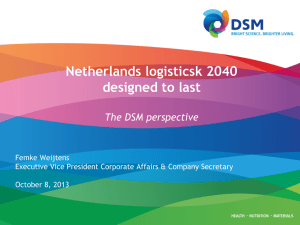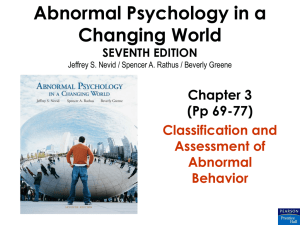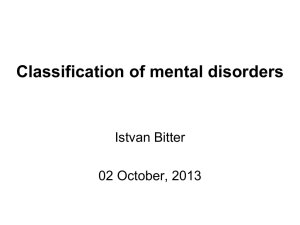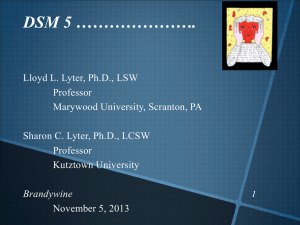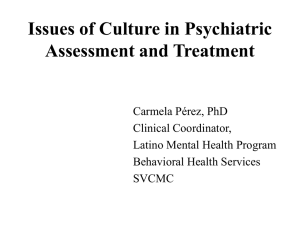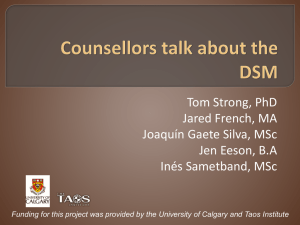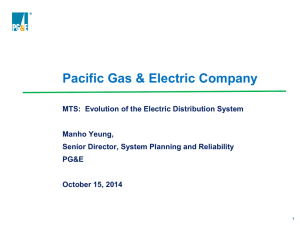Presentation
advertisement
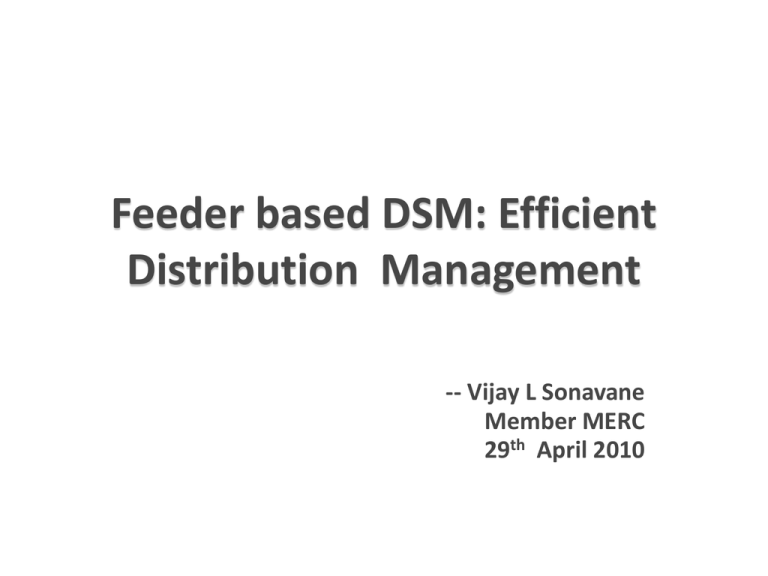
Feeder based DSM: Efficient Distribution Management -- Vijay L Sonavane Member MERC 29th April 2010 Issues for Discussion Features of conventional DSM initiatives Rationale for feeder-based DSM programs Feeder-profile & Consumption pattern analysis Feeder-based implementation process Summing up.. Features of conventional DSM initiatives Conventional DSM initiatives • DSM system initiatives focus on largescale/dispersed promotion of Load Management & Conservation measures • Examples: – CFLs in Urban/Rural sector or FTLs in multiple areas – Fans, A/Cs and Refrigerators: Urban System – Commercial building chiller replacements: Metro System • Measurement & Verification done through: – Engineering calculations & Actual metering • Apparently difficult to notice the savings TOU tariff: DSM Option • Time Of Use (TOU) tariff: Important DSM option • Cost of purchasing peak power is the highest, so energy charges for peak time should be high • Basic aim: to reduce peak time use of energy • TOU tariff concept right from first MERC tariff order in May 2000. • TOU tariff for: HT Industries/ HT PWW/ LT Industries & LT Com: > 20 KW DEMD/ LT PWW/ HT Com TOU for IND HT • Basic tariff EXP: 505 Ps/U, Non-Exp: 460 Ps/U Time Slots: TOU Tariff : TTL tariff : Hrs in week 06-09 & 12-18 : 00 PS/U : 505 PS/U : 63 09-12 : (+) 80 Ps/U : 585 PS/U : 21 18-22 : (+) 110 PS/U : 615 PS/U : 28 22-06 : (-) 85 PS/U : 420 PS/U : 56 Average tariff = 505 PS/U • Consider a consumer uses 1 Unit all throughout the day • TOU charges: 3x80 + 4x110 + 8(-85) = 240+440-680 = 00 PS • No incentive for shifting of loads for continuous IND International practice for TOU tariff • Pacific Gas & Electric Co. US (Res tariff) (from 1st March 2010) Residential (E-6): Base line Energy charges: • Summer: (May-Oct) Peak : 01-07 PM (Mon Fri) : $ 0.30142 (30 H) Partial Peak: 07-09 AM & 10 AM-0100 PM (MF) & 05-08 PM (Sat) : $ 0.14865 (38 H) off-peak: All other periods : $ 0.10324 (100H) Average Tariff= $ 0.1477 PU • Winter (Nov-Apr) Partial Peak: 05-08 PM (Mon Fri) Off peak Average tariff = $ 0.092197 PU : $ 0. 10319 (15 H) : $ 0.09112 (153H) TOU in MSEDCL (Feb 2010) Category HT IND Consumer TOD Nos. meters Nos. Consumpt Consumpt Consumpt Consumpt ion 2200- ion 06-09 ion 09-12 ion 18-22 0600 & 12-18 12920 12913 32.4% 38.0% 13.0% 16.5% 760 753 33.0% 38.1% 12.6% 16.3% 15,081 4396 27.2% 45.6% 12.3% 14.9% LT-IND< 27 HP 2,20,219 67,607 16.8% 47.1% 14.5% 21.6% LT IND> 27HP 46,452 35,147 26.0% 43.0% 15.1% 15.8% LT COM 9762 5016 21.3% 46.3% 13.5% 18.9% 33.3% 37.5% 12.5% 16.7% HT-PWW Other HT/LT >27HP Example (*) (*) Consider 1 MW continuous load Power Factor Penalty/ Incentive • For HT IND/Com/PWW/ AG/ HT RC/ LT Com & IND >20KW, LT PWW LT • For PF> 0.95, 1% incentive of amount of monthly bill, for each 1% improvement in PF > 0.95. For 0.99 PF, incentive is 5% & for unity PF Incentive is 7% • For <0.90 PF, penal charges shall be @2% of the amount of monthly bill for first 1% fall below 0.90, beyond which penalty is 1% for each % point fall in PF. • In FEB 2010 billing, 18,647 Consumers paid PF penalty of Rs 7.41 Crores & 30,800 consumers got PF Incentive of Rs 73.17 Crores. • Installation of Capacitors Higher PF PF incentive Rationale for feederbased DSM Context of feeder-based DSM initiative … a scenario Source Reliability Price Revenue collection Sub Station MW, MU, PF, THD, V, f -- Demand interface Consumers – (Domestic, Industrial, PWW, Commercial) -- Interface leading to reduced demand-supply gaps Supply position Advantages of feeder-based DSM options • Utility can choose feeders, where: – Transformer loading is high – Cost-to-serve is high • Existing DT and feeder metering & Energy Accounting infrastructure will be used for feeder based DSM • Pre & post-DSM implementation: energy throughput and load data will be used • Easy to track savings • Savings can provide essential equity in project selection Feeder-based DSM implementation & SMART-Grids Integrated communications … real-time information & control ◦ Remote data acquisition, real-time triggers (at consumer end) Sensing & measurement technologies…remote monitoring, TOU and DSM ◦ Online/”visible” knowledge of fossil/Green Power & energy costs; real-time switch over between energy sources ◦ Demand-response programs Advanced control methods…rapid diagnosis ◦ Apriori knowledge of grid failures, support to data centers, hospitals (essential loads) Improved interfaces & decision support ◦ Higher integration with the load dispatch functions Feeder profiles/ Consumption pattern Analysis Feeder & DT metering: Issues • • • • 11,401 feeders (11/22/33KV)/ 2.86 Lakh DTs Monitoring of feeder & DT Meter status Metering System: (Meter + CTs + PTs) At EHV & 33/11KV, 22/11KV substations hourly meter readings are taken, but at many places, only Ammeters are available. • DT metering & DT meter reading is an issue • Consumer Indexing (DT Consumers) Analysis of consumption (per consumer utilization) (1/3) Category R- BPL Consumer Nos. MU sale (Apr 09 – Feb 10) Per consumer per month units Per consumer per month bill in RS Rs Per unit AVG billing rate 2.77 L 57 19 24 1.25 111.51 10586 86 378 4.39 R- HT Res Complex 379 298 71,500 3,57,390 5.00 Com- LT II 12.02 L 2868 217 1770 8.15 Com- HT Com 2786 1434 46,792 4,66,950 9.95 Com- LT Hording 1564 3 1918 29,700 15.48 R- Dom LT I Analysis of consumption (per consumer utilization) (2/3) Category Consumer Nos. MU sale (Apr 09 – Feb 10) Per consumer per month units Per consumer per month Bill in Rs. Rs Per unit AVG billing rate HT-IND Express 1602 13510 7.67 L 38.5 L 5.01 HT-IND Non Express 8784 7179 74,000 3.77 L 5.07 LT IND 2.37L 2971 1140 63,214 5.55 PWW-HT 767 1230 1.46 L 5.82 L 3.99 PWW-LT 45430 437 874 2101 2.40 St. Light 67619 659 886 3226 3.65 Analysis of consumption (per consumer utilization) (3/3) Category Consumer Nos. MU sale (Apr 09 – Feb 10) Per consumer per month units Per consumer per month bill in Rs. Rs Per unit AVG billing rate 1063 435 45,468 38,700 0.85 LT AG 27.48 L Met: 13.43 L Un met 14.05 L 11,802 477 290 0.61 LT Power Loom 45,430 2259 2466 4990 2.02 MSEDCL 15.87 M 57,596 3299 13,307 4.03 Govt. Tariff Subsidy HT AG Salient Observations for MSEDCL • Average Monthly Consumption (Units/consumer/month): Res: 86 Com:217 LT IND: 1140 LT PWW:874 LT AG: 477 LT Hoardings: 1918 St Light: 866 • LT AG/Consumer/Month consumption is higher than Res & Com • ABR: (PS/Unit) Res: 439 LT, Com: 815, HT COM: 995, St. Light: 365 LT Hording: 1548, HT-R Complexes: 500, LT PWW: 240 HT IND E: 501, LT IND: 555, HT PWW: 399, HT AG: 85, LT AG: 61, P/L: 202 (AVG ABR: 403 PS/U) • Taking Consumer/ feeder/ DT meter readings at regular interval is essential. Billing through Assessment has to be minimized. • Pilot project results should be discussed at all levels during various review meetings. COMPARISON of UTILITIES in Maharashtra (LT Res Consumers) Utility MSEDCL Average monthly Units consumption in R category Per Unit billed revenue in Ps/unit Consumers having consumption < 100 & < 300 Units/Month TTL Residential consumers 86 378 89.70 L 111.51 L BEST 219 915 100 U:2.20 L 300 U :3.56 L 7.07 L RInfra-Dist 144 757 100 U:9.53 L 300 U:12.02 L 26.18 L TPC-Dist 177 734 100 U:39,833 300 U:61,810 1.37 L Consumer Base Vs Sale (%) analysis Sector Consumer base (%) Utilization /Sale (%) Remarks Residential 72.0% 19.0% Commercial 7.6% 7.5% Industrial 1.6% 41.1% First priority Power loom 0.3% 3.9% Second Priority Agricultural 17.3% 21.2% Fourth Priority PWW/ Street light 0.7% 4.0% Third Priority Type of Feeders in MSEDCL Sr. No. Type of feeder 1 EHV/HV Express 544 4.8% 2 MIDC 816 7.2% 3 Public Water Supply 243 2.1% 4 Urban 2548 22.3% 5 Mixed Rural (1 PH + NO LM) 4639 40.8% 6 Separated AG 1353 11.9% 7 Separated Gaothans 1228 10.9% 11,401 100% Total Nos. % Feeder-based DSM implementation process Feeder-based DSM Project Development Feeder identification: Sequence: EHV/HV IND EXP, Non Express feeders, MIDC feeders, PWW feeders, Separated AG & Gaothan Feeders, Urban, Rural feeders Data generation: feeder wise consumer mapping Data analysis: Pre DSM consumption data & expected results after DSM DSM benefit-cost analysis: Energy savings Tendering & implementation: Period to be minimum Monitoring and verification: Third party evaluation 24 DSM Program process Identify project & negotiate with customers Prepare standard offer agreement Initiate project Utility actions Submit initial application Approve or reject application Submit installation report Make performance payments Approve initial application based on defined criteria Allocate / reserve funding Finalize measures and prepare M&V plans Submit final application Approve or reject installation report Make installation payment Approve or reject savings reports Conduct M&V activities and submit savings reports Project sponsor actions 25 Rural feeder-based DSM options • DSM Scheme can be developed around: – Energy throughput at the rural 11 KV interface (meter) – Linking of ( i) agriculture pumping,(ii) rural industries, (iii) households and (iv) municipal systems (lighting, water pumping) as a seamless module • DSM integration options include: – – – – Efficient end-use in the rural household (CFL, EE fans) Efficient pumping: EE pumps (Mangalvedha Project) Water conservation measures (saving water & Energy) Productive use of biomass (Gassifiers & Biomass Fuel) 26 Urban feeder-based DSM options • Mixed feeders with commercial, publicbuildings, water pumping and residential feeders: – Energy throughput at dedicated sub-station or 33/11 KV interface (Correct metering) – Benefits from variety of end-users (Mixed feeder) – Lighting (CFL, FTL), Star rating Fans, A/Cs & Refrigerators, EE Society water pump/motor, Commercial use to be reduced, LT Industries: EE motors, Capacitors. 27 Summing up … Conclusions … • Benefits of DSM are the best on feeders & DTs which are overloaded. Immediate CAPEX investments can be deferred, for some time. • High Quality of metering of feeders & DTs is required for getting the benefits of demand shift, Energy Conservation & Load Management • Sequence of Feeder DSM implementation: Dedicated AG/IND feeders, MIDC areas, Commercial buildings, housing complexes, mixed Urban feeders & mixed Rural feeders with AG/village loads • Monetization of benefits of such locations will yield true costbenefit analysis of such efforts. “If it is to be… It is up to me!” Mother Teresa 30 THANK YOU!! (email : vlsonavane@gmail.com) " My motto in life is that… Nothing is impossible, No target is unachievable… One just has to try harder and harder…" KIRAN BEDI 33 “Dream is not what you see in sleep. Dream is the thing which does not let you sleep.” 34
